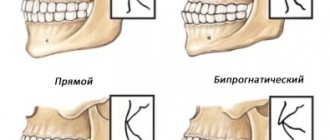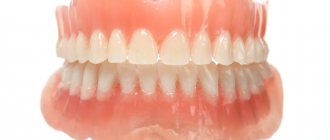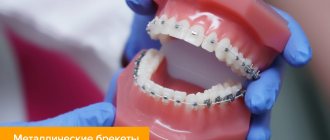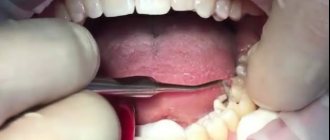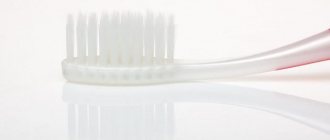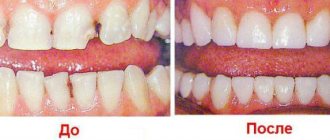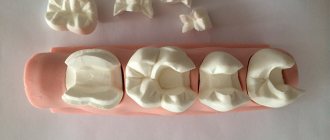Microprosthetics in dentistry
This technological direction has a number of advantages over other methods. Teeth are restored in a gentle way, in most cases without damaging those nearby.
The structures that are used for such prosthetics, such as inlays and onlays, are made from casts. They are much stronger and also more durable than photo fillings or crowns.
In this way, you can achieve a flawless, “Hollywood” look to your teeth. This is proven by various photos of microdental prosthetics, which can be seen on the website of the Implantmaster clinic, as well as on other resources on the Internet.
Adhesive microprosthetics
Adhesive microprosthetics is used in the absence of supporting lateral units. The system is not installed in the molar area due to its low strength. The prosthesis is attached to the base healthy teeth using a special adhesive material and consists of three components: a central artificial crown, two side inlays.
Before installation, carious lesions are eliminated, professional sanitation is carried out, notches are made on the supports into which fiberglass inlays are inserted. As a result, the patient receives a reliable, beautiful, functional and durable system.
The choice of design is determined by the individual clinical characteristics of the patient: the length/topography of the defect, the state of antagonists and supports, the morphology of a symmetrical tooth, the configuration of the alveolar process, age-related changes.
Stages of treatment
Dental restoration is performed using two methods - non-invasive and invasive (grooves are created along the edges of the defect into which locks/fiberglass bases are mounted):
- Before making a decision to carry out a procedure, the dentist conducts a consultation, examination, studies anamnesis, makes a diagnosis, and draws up a therapeutic regimen;
- electroodontodiagnosis and computer RG visiogram are performed;
- The oral cavity is first sanitized, and, if necessary, diseases are treated, fillings are performed, and pins are installed. Preparations for prosthetics are carried out: processing with a special tool to improve the fixation of enamel and composite;
- impressions are taken, models are formed, wax is applied;
- the surface of the units is treated with medications, covered with a composite, polymerization, bite adjustment, and polishing are carried out.
Advantages of microprosthetics
:
- gentle effect on adjacent teeth - the risk of damage to a row tends to zero;
- high efficiency and functionality - marked improvement in aesthetic and functional indicators, chewing functions;
- the use of high-quality materials and laboratory production of prostheses guarantee a long service life;
- the possibility of using ceramics as a restoration material, which is durable and resistant to aggressive microdentia/temperature changes;
- the possibility of restoring damaged teeth with precise preservation of occlusal relationships;
- the possibility of replacing 1-2 missing units with a bridge-like restoration on fastenings without grinding the supports for crowns made of metal-ceramics, zirconium and other types of material.
Oral care
The positive characteristics of dental microprostheses are resistance to caries, resistance to staining, therefore, with proper care, veneers fully function for 20-25 years, ceramic dental inlays for 10-13 years, and fiberglass restorations for 5-7 years.
To maintain the ideal condition of microprostheses, hygiene should be observed after treatment. You need to brush your restored teeth twice a day, use antibacterial rinses and floss. Try to avoid excessive stress on your teeth and do not eat too hard foods. Visit the dental office regularly for preventive examinations. With proper care, microprostheses will serve you for many years.
Our team of doctors
Maxillofacial surgeon, Implantologist
Bocharov Maxim Viktorovich
Experience: 11 years
Dental surgeon, Implantologist
Chernov Dmitry Anatolievich
Experience: 29 years
Orthopedist, Neuromuscular dentist
Stepanov Andrey Vasilievich
Experience: 22 years
Endodontist, Therapist
Skalet Yana Alexandrovna
Experience: 22 years
Orthopedic dentist
Tsoi Sergey Konstantinovich
Experience: 19 years
Dentist-orthodontist
Enikeeva Anna Stanislavovna
Experience: 3 years
Indications and contraindications
Since the veneer covers only the outer part of the incisor, and the crown encapsulates the entire tooth, indications for microprosthetics vary. If the filling material replaces most of the dentin and enamel, then a crown is installed. But if you need to carry out cosmetic restoration, then installing veneers will be the optimal solution.
Other indications for microprosthetics:
- correction of minor tooth curvatures;
- presence of aesthetic defects: stains, cracks, chips;
- filling abnormally enlarged spaces between elements of the dentition.
Types of microprosthetics
Due to the wide scope of application of this technique, several varieties are used.
- Prosthetics using pins - this method restores a damaged crown, provided that the tooth root is still healthy. A pin is inserted into the root, onto which a new crown is already attached. In this case, neighboring teeth are not damaged or ground down.
- Prosthetics with onlays, or veneers, allow you to restore the aesthetic appearance, improve the shape and color. Overlays, in the form of thin plates, about 0.5 mm thick, are installed in areas of chipping, darkening or abrasion of the enamel. Thus, the destruction of the dentition from external influences such as cigarette smoke, coffee, tea, as well as physical damage is prevented. Veneers are typically made from zirconia ceramic or porcelain. These onlays come in three varieties - lumineers, porcelain onlays and composite veneers.
- Prosthetics with inlays, stumps and restorations - used in case of caries, closing the root canal after treatment, instead of fillings. Tabs restore the chewing surface. Restorative ones correct the shape and color, stump ones restore the coronal part. Such fillings are made in special laboratory conditions; they are much stronger and more durable than other types. In addition, they look very aesthetically pleasing.
- Adhesive microprosthetics of a missing tooth - in this case it is replaced with a prosthesis. It is made using elastic fiberglass or plastic, which have very high strength. On its basis, a prosthesis in the form of a bridge with a long service life is manufactured. The fiberglass bar is attached, using adhesive, to the adjacent teeth. For this purpose, small notches are made on their surface, less than 2 mm deep. A prosthesis is formed on the beam by polymerizing a special material under the influence of light. This technique is recommended for those people who are allergic to the metal used in dentures.
Why is an inlay better than a filling?
- The inlay more accurately follows the shape of the tooth cavity and fits more tightly to the tissues during fixation - because it is made according to individual impressions in the laboratory.
- The risk of caries at the junction between the inlay and the tooth is minimized.
- A dental inlay is much more durable than a filling. Service life 20 years. Not a single filling can last that long and perform all its functions efficiently.
- Ceramics is a durable material; the inlay can withstand a stronger chewing load than a filling.
- The inlay reliably protects the tooth from further destruction.
- There are no downsides to miprosthetics! The only thing is that it will be more expensive than a filling. But the tab does not need to be changed every 3-5 years, as it should be done with a filling.
How microprostheses are installed
Many naively believe that microprosthetics are performed quickly, in 1-2 visits to the attending physician. In fact, this is completely wrong. This procedure is performed in several stages.
- An initial examination, the purpose of which is to determine the condition of the oral cavity, as well as to identify diseases that may interfere with this method of treatment. If any of the diseases is detected, it is necessary to treat it, which can take quite a long time.
- Preparing and taking an impression – after treatment, the tooth is processed. The top layer of enamel is ground down to install the lining, or the place where the chewing surface is destroyed is undermined. An impression is made using plaster, and a temporary veneer is installed for the patient.
- After a few days, the finished microprosthesis is checked and further processed if necessary.
- Finally, it is installed in place using cement.
Microprosthetics with veneers
Veneers
- thin plates that are attached to the vestibular surface, replacing the enamel. Ready-made microprostheses fit tightly to the tooth, restore aesthetics and anatomy: hide darkening of the front teeth included in the smile zone, areas of abrasion, chips, improve color, and close gaps between the frontal units.
Standards for the manufacture of direct restorations (directly in the patient’s oral cavity) provide for preparation (grinding) of the surface, the use of adhesive, and layer-by-layer application of the composite.
The thickness of the plate is determined by the severity of the defect; at the final stage, the doctor performs grinding and polishing to achieve 100% identity of the finished veneer and natural neighboring units. Indirect ones are made in the laboratory on a jaw model.
pros
: satisfactory cost, preservation of fabrics, predictable and quick results, possibility of repair, excellent aesthetic properties, natural shade.
Minuses
: difficulties in regenerating symmetry, loss of shine, abrasion, the need for constant polishing.
In what cases are veneers installed?
:
- unaesthetic units: altered shade of enamel that cannot be corrected by classical whitening methods: pigmented cracks, tetracycline teeth, fluorosis;
- imperfect form: wedge-shaped anomalies, injuries, enamel hypoplasia, increased abrasion;
- tilting/rotation of teeth;
- presence of cracks;
- “gummy smile” - visualization of more than 2 millimeters of gum when smiling;
- the presence of discolored, multiple fillings;
- the need to correct the aesthetics of the central segment of the row by changing the anatomy of the crowns of an impacted tooth, with edentulism.
Restrictions
: onlays are not placed if the dentofacial apparatus is insufficient - regeneration of the chewing function should always be a priority. Indirect veneers cannot be used in cases of extensive carious lesions, significant damage to the crown/enamel, or allergic reactions to working materials/components.
Rules of care
They care for dentures in the same way as for healthy teeth, only you need to use pastes with soft abrasives. You should not try to bleach them - this approach will not help, and may even harm. Toothbrushes should also be soft. You need to forget about whitening and cleaning your teeth at the dentist. To prevent the enamel from darkening, it is enough to get rid of bad habits - such as smoking, drinking less coffee and tea. Nutrition should also be balanced.
Prices for microprosthetics at Implantmaster are very affordable, and in many cases treatment is cheaper than in other clinics. At the same time, the qualifications of doctors and the quality of patient care are at the highest level.
Author:
Microprosthetics of a missing tooth with inlays
Tabs
- non-removable structures that restore the functional/anatomical integrity of bone tissue destroyed due to traumatic injuries, wedge-shaped defects, enamel hypoplasia, caries - when this cannot be done using filling materials.
They are classified according to topography (masticatory, distal, medial, occlusal surfaces), manufacturing technology, material, purpose (basic, regenerating, splinting).
This option is indicated for the treatment of teeth with 60-75% destruction. Stump inlays differ from ordinary ones in the way they are fixed: they are attached to the root and coronal part.
They are created individually, completely repeating the structure of the canals, without putting strong pressure on the root system, which preserves the health and increases the service life of the living unit.
Microprosthetics with inlays have the following advantages
:
- good aesthetics and wear resistance/strength;
- the ability to control the shrinkage of the material during treatment;
- less pressure on the remaining walls of the formed cavity, which prevents the formation of cracks;
- sufficient adaptive characteristics;
- the ability to maintain a tight interdental connection;
- accessibility of perigingival/proximal surfaces for treatment;
- reducing the time spent at the dentist.
The clinical service life of inlays without loss of quality is 10-15 years. For comparison: composite restorations last 5-6 years, fillings - 8-10 years.
Flaws
: a large number of stages of therapy, the likelihood of galvanic manifestations and allergic reactions.
Average prices in Moscow clinics
The cost of microprosthetics directly depends on how many teeth need to be treated. Classic porcelain veneers cost from 80,000 to 25,000 rubles per tooth. If the patient plans to restore the entire dentition, the dentist will provide a discount.
For the installation of ceramic crowns you will have to pay from 15,000 to 45,000 rubles. Price for additional splinting of teeth: 2000-3000 rubles.
Microprosthetics will be an excellent solution for those who are not ready for large-scale, expensive restoration procedures.
The advantage of the microprosthetics method.
Microprosthetics compares favorably with other methods of tooth restoration. Among its advantages:
- Safe for adjacent teeth. Even with adhesive microprosthetics, there is minimal impact on neighboring teeth.
- Rapidity. You will only need to make 2 visits to the clinic to install a microprosthesis.
- Strength. Microprostheses are much stronger than conventional fillings, which can chip over time.
- Accuracy. They are made from impressions, so they fit perfectly into the dentition and fit the bite.
- Durability. The average service life of a microprosthesis is 5-10 years.
- Aesthetics. Variability in the choice of material allows you to choose the shade of the microprosthesis to match your natural color.
- Functionality. Restored teeth not only look like real teeth, but also perform basic chewing functions.
